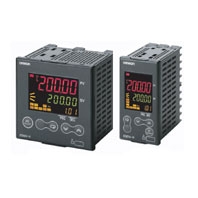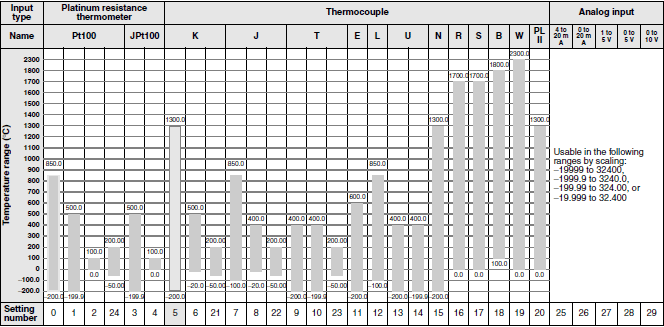| Power supply voltage | No D in model number: 100 to 240 VAC, 50/60 Hz
D in model number: 24 VAC, 50/60 Hz; 24 VDC |
|
|---|---|---|
| Operating voltage range | 85% to 110% of rated supply voltage | |
| Power consumption | 100 to 240 VAC: 12 VA
24 VAC/VDC: 8.5 VA (24 VAC)/5.5 W (24 VDC) |
|
| Sensor input | Any of the following can be selected.
Thermocouple: K, J, T, E, L, U, N, R, S, B, W, or PL II Platinum resistance thermometer: Pt100 or JPt100 Current input: 4 to 20 mA or 0 to 20 mA Voltage input: 1 to 5 V, 0 to 5 V, or 0 to 10 V |
|
| Input impedance | Current input: 150 Ω max., Voltage input: 1 MΩ min. (Use a 1:1 connection
when connecting the ES2-HB.) |
|
| Control method | ON/OFF control or 2-PID control (with auto-tuning) | |
| Control
output |
Relay output | Output Unit (Install the Output Unit (sold separately).) |
| Voltage output
(for driving SSR) |
||
| Current output | ||
| Linear voltage output | ||
| Relay output for
position-proportional control |
Relay output: Open and close: SPST-NO, 250 VAC, 1 A (including in-rush
current), electrical life: 100,000 operations min. Potentiometer input: Must be between 100 Ω and 2.5 kΩ for maximum open position. |
|
| Auxiliary
output |
Number of outputs | 2 or 3 max. |
| Output specifications | Relay output: SPST-NO, 250 VAC, 3 A (resistive load), electrical life: 100,000
operations, minimum applicable load: 5 V, 10 mA |
|
| Event
input |
Number of outputs | 2 or 4 (with an E53-AKB) |
| External contact
input specifications |
Contact input: ON: 1 kΩ max., OFF: 100 kΩ min. | |
| Non-contact input: ON: Residual voltage: 1.5 V max., OFF: Leakage current: 0.1
mA max. |
||
| Current flow: Approx. 7 mA per contact | ||
| Logic
operations |
Number of operations | 8 max. |
| Operations | Logic operation:
Any of the following four patterns can be selected. The input status may be inverted. (A and B) or (C and D), (A or C) and (B or D), A or B or C or D, A and B and C and D (A, B, C, and D are four inputs.) Delay: ON delay or OFF delay for the results of the logic operation given above. Setting time: 0 to 9999 s or 0 to 9999 min Output inversion: Possible |
|
| Output | One work bit per operation | |
| Work bit
assignment |
Any of The following can be assigned to up to eight work bits (logic operation
results): operation commands (assigned to event inputs)* , auxiliary outputs, or control outputs. * Application is possible with models that do not have event inputs by using an internal assignment. |
|
| Transfer
outputs |
Number of outputs | 1 max. (Depends on model. Models with transfer output (F in model number) |
| Output specifications | Current output: 4 to 20 mA DC, Load: 600 Ω max., Resolution at 4 to 20 mA:
Approx. 10,000 |
|
| RSP
input |
Number of inputs | 1 |
| Signal type | Current input: 4 to 20 mA (input impedance: 150 Ω ± 10%) | |
| Analog input scaling | Scaling of signal to engineering units (EU)
- 19,999 to 30,000 (display: 30,000 max.) |
|
| Accuracy | ( ± 0.2% of FS) ± 1 digit max. | |
| Input sampling period | 60 ms | |
| Setting method | Set digitally using keys on the front panel or by using the RSP input. | |
| Indication method | 11-segment digital display and individual indicators (7-segments displays also
possible) Character height: E5AN-HT: PV: 15.8 mm, SV: 9.5 mm, MV: 6.8 mm; E5EN-HT: PV: 11.8 mm, SV: 8.1 mm, MV: 5.8 mm Three displays: PV/SV/Program number/Segment number, PV/SV/MV, or PV/ SV/Remaining segment time. Number of digits: 5 for PV and SV, 4 for MV |
|
| Other functions | Manual output, heating/cooling control, loop burnout alarm, other alarm
functions, heater burnout detection (including SSR failure and heater overcurrent detection), 40% AT, 100% AT, MV limiter, input digital filter, temperature input shift, run/reset, protection functions, control output ON/OFF counter, extraction of square root, MV change rate limit, PV/SV status display, automatic cooling coefficient adjustment, program control functions, etc. |
|
| Ambient operating temperature | -10 to 55 °C (with no condensation or icing), for 3-year warranty: -10 to
50 °C |
|
| Ambient operating humidity | 25% to 85% | |
| Storage temperature | -25 to 65 °C (with no condensation or icing) | |
















